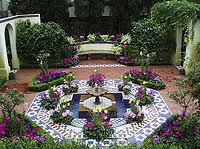WHEN the Moors invaded Spain in 711, they left a lasting legacy in many aspects of Spanish life.
In southern Spain, that influence can still be vividly seen in the gardens of Andalucia. The Moors brought with them a gardening tradition that had evolved in the Middle East. It was one based partly on religious beliefs, but one that was also well suited to deal with a hot, arid climate.
Their vision of paradise, a word of Persian origin that also means ‘garden’, consisted of an enclosed space, often containing water. In some cases, the water would be divided into four symmetrical branches, representing the four rivers that flowed through paradise.
This enclosed garden space allowed for a retreat from the harsh landscape that surrounded settlements in the Middle East.
Moorish gardens were not particularly about a stunning diversity of plants. In some cases, a courtyard might be planted in only one species. For example, a tightly clipped hedge of common myrtle (Myrtus communis, not related at all to Crape Myrtle) frames a rectangular pool in the Patio de los Arrayanes in the Alhambra.Or dozens of orange trees are laid out symmetrically in the Patio de las Naranjas (Court of the Oranges) of the Mezquita (Mosque/Church) in Cordoba, occasionally punctuated by the odd date palm or cypress.
Plants were generally not used solely for their visual appeal, but for fragrance and fruit as well. Orange trees would have provided shade, fragrant flowers and of course, oranges.
Over the hundreds of years that some of these gardens have been in existence, both under the Moors as well as with their Christian conquerors, the plant palette has
evolved.
So if you go to Spain looking for a perfectly preserved example of a 1,000-year-old garden, you might be disappointed.
Click here to read more News from The Olive Press.








